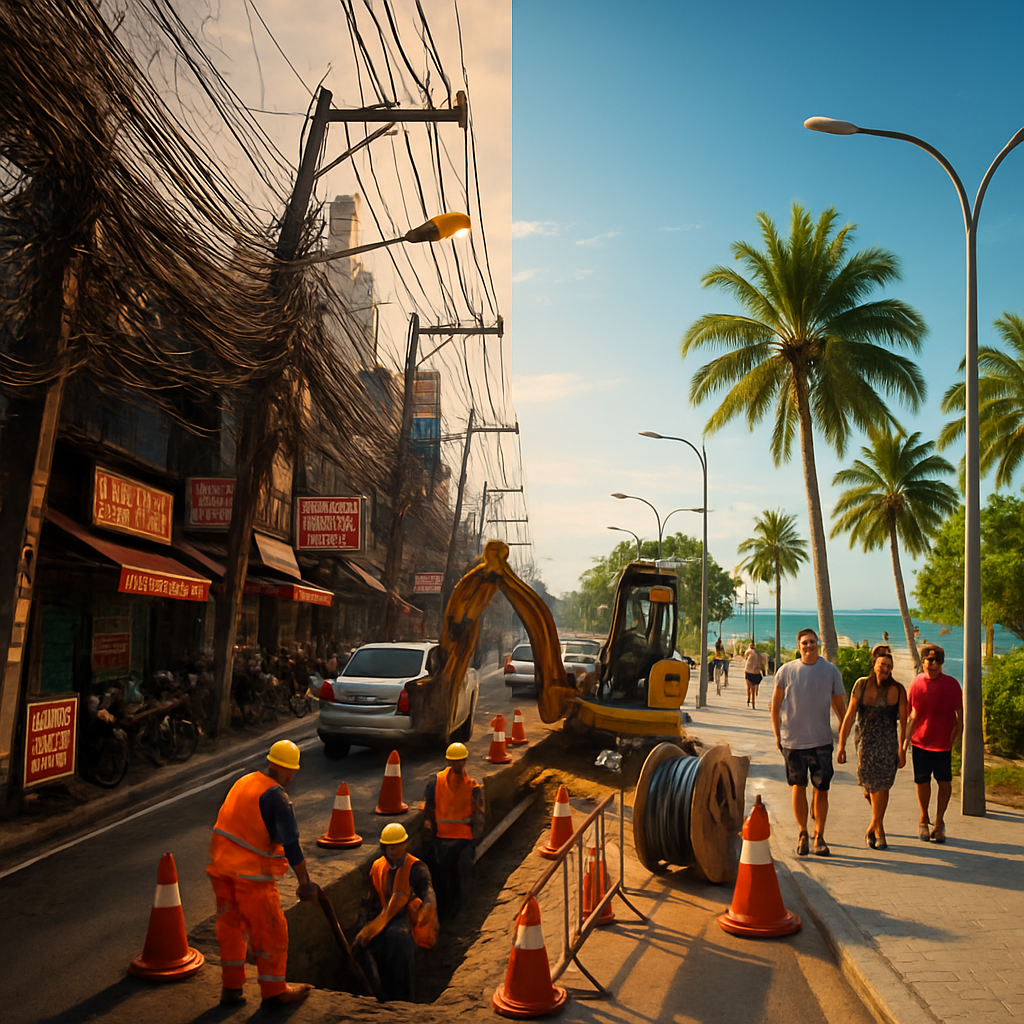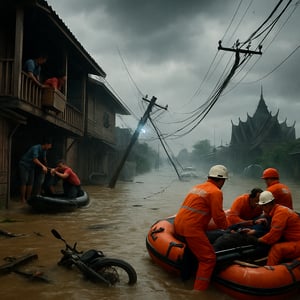Patong’s Power Move: Burying the Tangle for a Cleaner, Safer Streetscape
Patong is staging a low-key revolution — one that’s literally going underground. In a bold effort to tidy up its skyline and make streets safer for tourists and residents alike, the resort town has kicked off a 224 million baht project to bury power and telecom lines along five key thoroughfares.
The plan covers nearly 1.8 kilometres of urban arteries, routing cables out of sight along Bangla Road, Thaweewong Road, Sawatdirak Road, Ruam Jai Road, and Prachanukroh Road. It’s part of a long-running push by the Provincial Electricity Authority (PEA), with Patong Municipality chipping in substantial funding to get the job done.
Money where the meters are
The budget breakdown is straightforward: Patong will contribute 84.45 million baht to cover engineering and municipal works, while the PEA will pour in 137.53 million baht to overhaul the electrical system. The construction contract went to ASEFA Public Co. Ltd., which won the e-bid at 205.9 million baht — the lowest qualifying bid according to the official PEA announcement.
Where the first shovels hit
Work has already started on the town’s most famous (and busiest) stretch, Bangla Road, with crews aiming to wrap up that phase by early January. The next stage — along Rat-U-Thit 200 Pi Road — is slated to begin in April. Officials have been clear: this isn’t a sprint but a carefully phased program designed to minimize disruption while delivering long-term benefits.
Why it matters
Mayor Lalita Maneesri emphasizes the practical stakes: “The work aims to improve public safety, protect infrastructure from weather-related damage, and support future growth in electricity and telecommunications.” In short: fewer live wires dangling in storms, fewer outages after heavy rains, and more capacity for the digital needs of a booming tourist hub.
- Safety: Buried cables reduce the risk of electrocution and accidents during storms or vehicle collisions.
- Reliability: Underground systems are less prone to weather-related damage, lowering the chance of blackouts.
- Appearance: Removing the web of overhead cables cleans up the streetscape — a simple, visible boost to Patong’s curb appeal.
Ceremony, cameras and community
A ribbon-cutting-style ceremony at the Patong Beach entrance to Bangla Road marked the project’s commencement, with key local figures on hand: Council President Weerawit Krueasombat, NBTC Region 42 Director Mahama Kaje, PEA Region 2 officer Somsak Samranrat, local police and telecom representatives. The event signaled unified support — municipal, regulatory and private — for a project designed as much for residents as for the millions of visitors who flock to Patong each year.
Who does what
While the PEA handles the power system overhaul, the National Broadcasting and Telecommunications Commission (NBTC) is focused on telecom cables. NBTC’s role is crucial: telecom lines have become a chaotic fixture in Patong’s skyline, posing both safety concerns and a visual blight in tourism-heavy zones.
Thammarong Chuayaksorn, Chief Administrative Officer at Kathu District Office, summed it up: “Placing telecom lines underground will reduce service disruptions, prevent accidents, and improve the city’s appearance in areas with high tourist traffic.” The message is clear — it’s about function and form.
Expect temporary inconvenience for a lasting upgrade
Officials warn that motorists and businesses should expect temporary lane closures and restricted access in active work zones. “Updates on route closures will be announced in advance,” they say, asking for patience as crews work methodically to minimize chaos. For business owners along affected streets, advance notice aims to mitigate the impact on deliveries, customers, and daily operations.
Big-picture payoff
Beyond the immediate improvements, city leaders frame the project as a cornerstone in Patong’s long-term vision: a modern, safer, more visually appealing destination. For a town whose economy is tightly linked to its image, clearing the skies of cluttered cables is both a practical upgrade and a branding win.
So next time you stroll down Bangla Road and notice a cleaner skyline and fewer utility poles in your selfies, you’ll know why: Patong chose to bury the old tangle in favor of a future that looks — and feels — brighter, safer and more streamlined.


















This is a good idea for tourists — looks prettier and feels safer without all those wires. But 224 million baht sounds huge; who’s really paying and who benefits most? I hope small shop owners along Bangla Road get real support during the closures.
Shop owners deserve compensation or working-hour adjustments; lane closures will kill business days for many. The municipality should publish a clear mitigation plan with timelines and financial help.
Exactly — transparency is key. If they release day-by-day schedules and offer signage/alternate access, losses could be reduced and trust increased.
When governments do projects like this they always promise help then it trickles down to nothing. Hope you’re right, Joe, but I wouldn’t bet on it.
From an urban planning perspective, undergrounding utilities yields long-term value through decreased outage costs and improved urban aesthetics. The capital expenditure is large, but lifecycle cost analysis often favors burial in storm-prone tourist centers.
Nice to see data-backed support. Can you point to similar towns where it paid off? That would calm local fears.
Are we sure the bid process was clean? ASEFA is the lowest qualifying bid, but that doesn’t mean it’s the best one. Corruption in construction contracts is common; independent audits should be mandatory.
As a PEA officer, I assure you procurement followed rules and the lowest qualifying bid won fairly. Audits are standard and the PEA files are open to oversight bodies.
Somsak, thanks for the clarification but openness in practice matters — will those audit reports be public and in English?
Transparency is a public good. Even if procedures were followed, publishing contracts and progress photos would build trust among locals and tourists.
Can someone explain why burying cables is better than just trimming and organizing them? This sounds like making things expensive for pretty pictures.
Organizing overhead lines reduces clutter but doesn’t mitigate storm damage, salt corrosion, or the risk of falling poles. Underground systems are less visible but require a different maintenance regime and initial high cost.
Maintenance underground sounds expensive too. Who pays when a cable has to be dug up again?
True, but modern access chambers and mapping reduce future digging. Plus, reliability gains mean fewer costly emergency repairs after storms.
The municipality is committed to minimizing disruptions and protecting livelihoods during construction. We held discussions with business owners and will provide advance notices on closures.
Advance notice is nice, Mayor, but will you offer tax relief or compensation for days when businesses must close? A promise without money isn’t enough.
Pipat, we are assessing targeted support options and will announce measures that can mitigate short-term losses, including flexible delivery windows and help with signage for alternate entrances.
As a local teacher, I think cleaner streets will make tourists happier and maybe bring safer walking routes for kids. But construction noise and dust could harm students if schools are nearby.
We coordinated with schools to adjust schedules where necessary and install temporary barriers to control dust. Child safety is a priority during the works.
Appreciate the response, Councilor. Please make those arrangements public so parents can plan ahead.
Bangla Road is a tourist icon; this could be the cosmetic refresh it needs. But I worry the project treats appearance over local infrastructure concerns like drainage and waste management.
A holistic approach is necessary — if undergrounding proceeds, it should be integrated with improved drainage and smart street lighting to maximize benefits.
Exactly. If they do it piecemeal we’ll spend again later to fix the other problems.
Integration reduces total lifecycle costs and avoids repeated street cuts. Urban projects should bundle utilities and drainage upgrades when feasible.
NBTC and PEA coordination is crucial; telecom and power have different technical specs and maintenance needs. We’ll set clear demarcations for future repairs to prevent chaos underground.
Please publish the as-built maps. Too often cables are buried with no clear records and future digging destroys the system.
Agreed. We’ll provide detailed records to municipal authorities and emergency services, and some maps will be available to certified contractors.
If only they’d also bury ugly billboards and neon signs, Patong would look like a postcard.
What about flood risk? Underground cables can be vulnerable to flooding and saltwater intrusion in coastal towns. Was that factored into the design?
Designs usually include waterproof conduits, elevated chambers, and corrosion-resistant materials. However, in extreme flooding the risk increases and maintenance needs must be planned accordingly.
Good to know they considered it, but will those waterproof features be disclosed so residents can trust the project?
Public trust improves with transparent engineering specs; city should host a technical briefing for community stakeholders.
224 million baht could fund many community projects instead. Are we prioritizing tourist aesthetics over healthcare or schools? Feels like money is going where it looks good, not where it helps most.
Tourism funds the town; improving streetscape arguably boosts revenue that supports hospitals and schools indirectly. It’s not either/or but a policy trade-off worth debating.
I get that, but I’d like to see a clear ROI model showing how much extra tourism revenue will be generated vs. the immediate social needs.
A proper cost-benefit should be published. Visible infrastructure can increase tourist spending but quantifying it is essential before committing scarce public funds.
I love the idea of cleaner photos and safer streets, but what about street vendors who rely on overhead power? Will their hookups be restored quickly?
We were part of consultations and expect temporary power solutions during the works. Still, delays can harm evening vendors who depend on electricity for food stalls.
Please ensure vendors get priority restoration; they are the heart of Bangla Road’s night scene.
Back in the day we fixed lines by hand; now everything costs a fortune and takes months. Nostalgia aside, I support fewer outages though — storms used to cut power for days.
OldTimer, your point shows why reliability matters in living memory. But we must balance heritage with modern safety and economic needs.
Exactly, Lee. Just don’t let modern ‘improvements’ erase local character.
If the project integrates fiber and future-proof conduits, this is a big win for digital infrastructure. However, the environmental footprint of construction should be minimized with local materials and waste plans.
PEA plans include conduits sized for future capacity and some recycled materials. Environmental management plans were part of the bid package.
Good. Public reporting on waste diversion and materials would still build credibility and set a precedent for other towns.
Contractors are required to follow the environmental management plan and submit monthly compliance reports to the municipality.
Quick wins matter: fewer live wires means fewer accidents during monsoon season. I’ll take temporary dust over a safer town any day.
Safety improvements also make it easier to promote family tourism, which could diversify the visitor base beyond nightlife crowds.
Exactly — my family used to avoid Bangla Road, but better infrastructure could change that.
But don’t forget the displacement risks for informal workers; safety improvements shouldn’t force locals out.